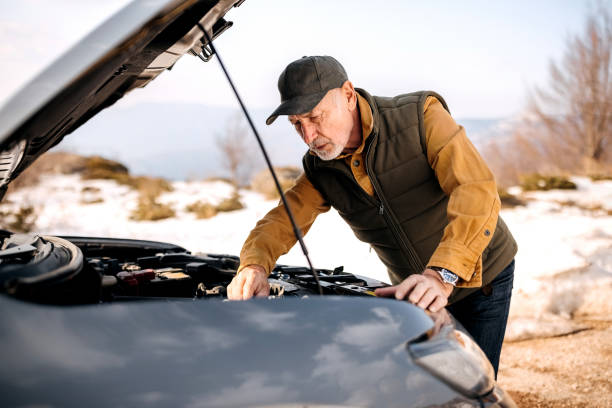1
Winter conditions transform roads into treacherous terrains that test even the most experienced drivers. Here’s a closer look at how winter affects driving surfaces and the common hazards you might encounter:
How Winter Affects Roads
- Snow and Ice: Accumulation of snow and ice reduces traction, making it harder for tires to grip the road.
- Black Ice: Invisible to the naked eye, black ice forms a thin, transparent layer over the road, creating extremely slippery conditions.
- Slush: Melting snow mixed with road debris creates slippery slush that can cause hydroplaning.
- Potholes: Freezing and thawing cycles can lead to potholes, which pose a risk to your car’s suspension system and tires.
Common Winter Driving Hazards
- Reduced Visibility: Snow, fog, and shorter daylight hours can significantly impair visibility.
- Longer Braking Distances: Icy roads increase the distance required to come to a complete stop.
- Skidding and Sliding: Loss of traction can cause your vehicle to skid or slide, especially on turns and inclines.
- Mechanical Failures: Cold temperatures can affect battery performance, tire pressure, and other vehicle components.
The Winter Car Safety Checklist
To ensure your car is winter-ready, professionals perform comprehensive checks on various components and systems. Here’s a detailed breakdown of what’s included in a winter car safety check and why each item is crucial for safe winter driving:
Battery and Electrical System
- Battery Health: Cold temperatures can reduce battery efficiency. Professionals will check for corrosion and ensure the battery is fully charged.
- Electrical System: Ensuring all electrical components, including lights, heaters, and defrosters, are functioning correctly.
Tires and Brakes
- Tire Tread and Pressure: Proper tread depth and tire pressure are essential for maintaining traction. Special winter tires may also be recommended.
- Brake System: Inspecting brake pads, rotors, and fluid levels to ensure optimal performance in slippery conditions.
Fluids and Wipers
- Antifreeze Levels: Ensuring the coolant system is properly filled with antifreeze to prevent the engine from freezing.
- Windshield Washer Fluid: Using a winter-grade washer fluid that won’t freeze in low temperatures.
- Wiper Blades: Checking for wear and tear to ensure they can effectively clear snow and ice from the windshield.
Heating and Defrosting Systems
- Heater: Ensuring the car’s heater is working efficiently to keep the cabin warm.
- Defrosters: Checking front and rear defrosters to maintain visibility through all windows.
Belts and Hoses
- Inspection: Cold weather can make rubber components brittle and prone to cracking. Professionals will check belts and hoses for signs of wear and tear.
Where to Get Your Winter Car Safety Check
The expertise and equipment required for a thorough winter car safety check are best found at certified service centers. Here’s why it’s crucial to use professionals and how to find reliable providers:
Importance of Certified Professionals
- Expertise: Certified mechanics have the training and experience to identify potential issues that could be exacerbated by winter conditions.
- Equipment: Professional service centers have specialized tools and diagnostic equipment to perform comprehensive checks.
- Warranty Compliance: Some vehicle warranties require maintenance checks to be performed by certified professionals.
Tips for Finding Reliable Service Providers
- Check Certifications: Look for ASE (Automotive Service Excellence) certification or other industry-recognized credentials.
- Read Reviews: Online reviews and testimonials can provide insights into the quality of service.
- Ask for Recommendations: Word-of-mouth referrals from friends and family can lead you to trustworthy service centers.
- Inquire About Services: Ensure the provider offers a complete winter safety check package.
Winter Driving Tips
Beyond professional checks, here are additional tips to help you stay safe on the roads during winter:
Driving Techniques
- Slow Down: Drive at a speed appropriate for the road conditions to maintain control.
- Increase Following Distance: Leave more space between your vehicle and the one in front to allow for longer braking distances.
- Avoid Sudden Moves: Gentle acceleration, braking, and steering can prevent skidding.
Emergency Kits
- Essential Items: Carry a winter emergency kit that includes blankets, a flashlight, a first-aid kit, non-perishable food, water, and extra clothing.
- Tool Kit: Include basic tools, jumper cables, a shovel, and ice scraper in your car.
- Communication: Make sure your phone is fully charged and have a car charger handy.
Winter driving requires more than just skill; it demands rigorous preparation. Professional winter car safety checks are a proactive step to ensure your vehicle can handle the season’s challenges, keeping you and your loved ones safe. One trusted provider for comprehensive winter safety checks in the UK is Protyre. Their certified professionals, state-of-the-art equipment, and attention to detail make them a top choice for ensuring your vehicle’s winter readiness.
Don’t wait until it’s too late. Schedule your winter car safety check with Protyre today and drive with confidence, knowing your vehicle is ready to face the icy roads ahead. Share this post with fellow drivers to spread the importance of winter preparedness. Take the first step towards a safer winter journey by booking your safety check with Protyre now. Stay safe and drive smart!


